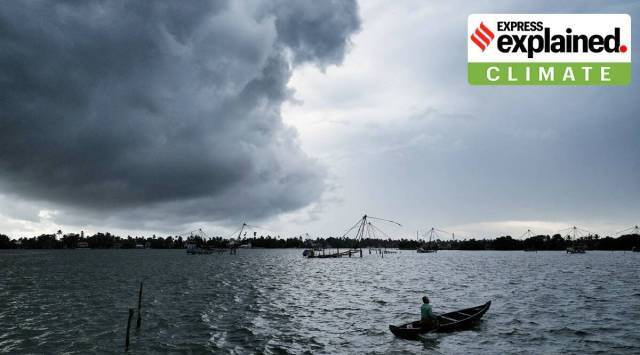What’s in today’s article?
- Why in News?
- What is ENSO (El Nino and Southern Oscillation)?
- What is Indian Ocean Dipole (IOD)?
- Does IOD Impact Southwest Monsoon?
- News Summary
Why in News?
- With the El Nino phenomenon almost certain to affect the Indian monsoon this year, high hopes are pinned on the development of a positive Indian Ocean Dipole (IOD) and its ability to counterbalance the El Nino effect.
What is ENSO (El Nino and Southern Oscillation)?
Image Caption: ENSO
- ENSO is one of the most important climate phenomena on earth due to its ability to change the global atmospheric circulation, which in turn, influences temperature and precipitation across the globe.
- Though ENSO is a single climate phenomenon, it has three states, or phases, it can be in:
- El Nino:
- A warming of the ocean surface, or above-average sea surface temperatures (SST), in the central and eastern tropical Pacific Ocean.
- It is associated with lower than normal monsoon rainfall in India.
- La Nina:
- El Nino:
- A cooling of the ocean surface, or below-average SSTs, in the central and eastern tropical Pacific Ocean.
- It is associated with a comparatively better monsoon rainfall in India.
- Neutral:
- Neither El Nino nor La Nina.
- Often tropical Pacific SSTs are generally close to average.
What is Indian Ocean Dipole (IOD)?
Image Caption: Indian Ocean Dipole
- The Indian Ocean Dipole (IOD) is defined by the difference in sea surface temperature between two areas (or poles, hence a dipole) – a western pole in the Arabian Sea (western Indian Ocean) and an eastern pole in the eastern Indian Ocean south of Indonesia.
- In scientific terms, the IOD is a coupled ocean and atmosphere phenomenon, similar to ENSO but in the equatorial Indian Ocean.
- A ‘positive IOD’ — or simply ‘IOD’ — is associated with cooler than normal sea-surface temperatures in the eastern equatorial Indian Ocean and warmer than normal sea-surface temperatures in the western tropical Indian Ocean.
- The opposite phenomenon is called a ‘negative IOD’, and is characterised by warmer than normal SSTs in the eastern equatorial Indian Ocean and cooler than normal SSTs in the western tropical Indian Ocean.
- The IOD was identified as an independent system only in 1999.
Does IOD Impact Southwest Monsoon?
- There is no established correlation between Indian summer monsoon rainfall and IOD.
- However, studies have shown that a positive IOD year sees more than normal rainfall over central India.
News Summary
- With the El Nino phenomenon almost certain to affect the Indian monsoon this year, high hopes are pinned on the development of a positive Indian Ocean Dipole (IOD) and its ability to counterbalance the El Nino effect.
- A positive IOD has the potential to offset the impacts of El Nino to a small measure in neighbouring areas.
- It has, at least once in the past (1997), delivered admirably on this potential.
- While the El Nino is already firmly established in the Pacific Ocean this year, the IOD is still in the neutral phase.
- All international climate models suggest a positive IOD event may develop in the coming months
- The India Meteorological Department (IMD), in its bulletin earlier this month, said there was an 80% chance of a positive IOD in the coming months.
Q1) How do we measure the temperature of sea water?
The temperature of seawater is measured using instruments called thermistors. The temperature of seawater can be measured to great accuracy with carefully calibrated modern thermistors – down to variations of 0.0001° C.
Q2) What are ocean currents in short answer?
Ocean currents are the continuous, predictable, directional movement of seawater driven by gravity, wind (Coriolis Effect), and water density. Ocean water moves in two directions: horizontally and vertically. Horizontal movements are referred to as currents, while vertical changes are called upwellings or downwellings.
Source: Indian Ocean Dipole: What is it, how it can limit El Nino effects
Last updated on June, 2025
→ UPSC Notification 2025 was released on 22nd January 2025.
→ UPSC Prelims Result 2025 is out now for the CSE held on 25 May 2025.
→ UPSC Prelims Question Paper 2025 and Unofficial Prelims Answer Key 2025 are available now.
→ UPSC Calendar 2026 is released on 15th May, 2025.
→ The UPSC Vacancy 2025 were released 1129, out of which 979 were for UPSC CSE and remaining 150 are for UPSC IFoS.
→ UPSC Mains 2025 will be conducted on 22nd August 2025.
→ UPSC Prelims 2026 will be conducted on 24th May, 2026 & UPSC Mains 2026 will be conducted on 21st August 2026.
→ The UPSC Selection Process is of 3 stages-Prelims, Mains and Interview.
→ UPSC Result 2024 is released with latest UPSC Marksheet 2024. Check Now!
→ UPSC Toppers List 2024 is released now. Shakti Dubey is UPSC AIR 1 2024 Topper.
→ Also check Best IAS Coaching in Delhi






















